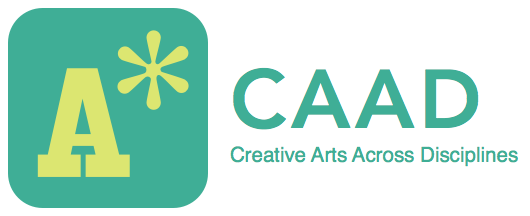When I first took on the task of creating a mural to represent the Collaboratory and all of the ideas it promotes, I believed it to be an impossible task; I thought of the infinite number of potential works the Collaboratory could both produce and display. These projects could involve work from a variety of disciplines, including visual art, music, history, philosophy, literature, dance, even physics and other sciences! As I thought of the construction of these projects, the image of many different hands working and interacting with one another really stood out in my mind; thus, not only did I hope to produce a visual representation of a variety of disciplines in my mural, but I also wanted to put an emphasis on collaboration between those with very different interests coming together, and the ways in which hands can communication this type of cooperation.
Thinking of the term creativity opened even more doors for me in terms of how I could go about constructing the mural. After interviewing faculty and students about creativity and what they do to feel inspired, I was introduced to many strategies people use to create the conditions necessary to do their best work. Some of these experiences were very simple, such as going for a walk, and others unexpected, such as sitting in a lecture. I wanted to include in my mural images that would evoke in the viewer feelings of both relaxation and creative stimulation.
I quickly came to the conclusion that collage would be a great medium to incorporate a large number of images into one mural. I spent several hours flipping through different magazines and cutting out images that spoke to me, either about collaboration or inspiration. Although I was able to collect a fair amount of images, I felt I needed some larger pieces to fill the vast size of the mural as well as to tie together the smaller magazine clippings. My main priority was to make the mural accessible to anyone, and to invite all viewers to have their own creative experience through this mural; however, I also wanted to include some of my own artwork. I cut out some figure drawings and landscape sketches and began pasting them to the mural, arranging them in a way that would be pleasing to the viewer and would allow their eyes to move across the mural from drawing to magazine image. I also filled some blank spaces with newspaper clippings. As an English major, words are something that I really value for both inspiration and expression, and I did not want this concept to be lost amongst so many images.
After putting down the majority of material, I felt very unsure of the direction in which the project was going.
I also felt that certain aspects of the arts and other disciplines were not being fully represented. I proceeded to paint some of my own images, including the hands representing work with both chemistry and painting: two activities that can come together in projects such as those supported by CAAD. I also drew film strips and music notes in emptier sections of the mural, for I felt these two areas of the arts needed more of a voice in this piece.
While I was pleased with the arrangement of the different types of images, I felt they looked very disconnected. I had a clear idea of what I wanted the final mural to look like, yet I felt unsure of how to get there. I realized that I needed inspiration and a way to relax so that I could work more fluidly in expressing myself and my creativity. I pictured myself sitting outside in the grass, because I know from past experience that this setting has really allowed me to let myself go and create some of my best work. This scene in my head ultimately appeared my mural, and really forced me to think of the mural in a new way.
I felt less in control of my work in the best way possible, and all of the thoughts faculty and students had about creativity really seemed to be playing out in the mural right before my eyes. As I continued to experiment with color, I had more and more fun with the mural, and felt it was becoming a greater representation of myself. I realized that in much of my artwork, I rely on color to express emotions and feelings that cannot otherwise be communicated; therefore I used color in the mural not only to connect the various images, but also to establish a specific mood in the work. After putting down my final brush strokes, I believed the mural had the amount of completeness that I wanted it to have, while still leaving room for the viewer to fill in certain gaps with their own images and ideas.
Although my process was both personal and complicated, I hope that in viewing my mural, people are provoked to think about their own creative processes, and all the bits and pieces that go into any creative project. I wanted to emphasize in my mural the idea that creativity does not come from a single discipline, but instead, draws from a variety of sources and experiences. I know that creating this artwork has certainly prompted me to think of these things, and if its time in the Palmer Gallery has done so for others, then I feel that my work is a success.



